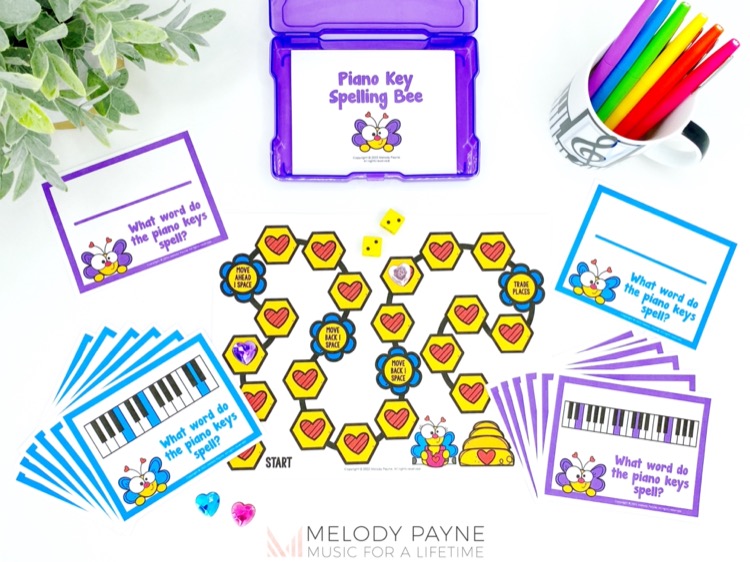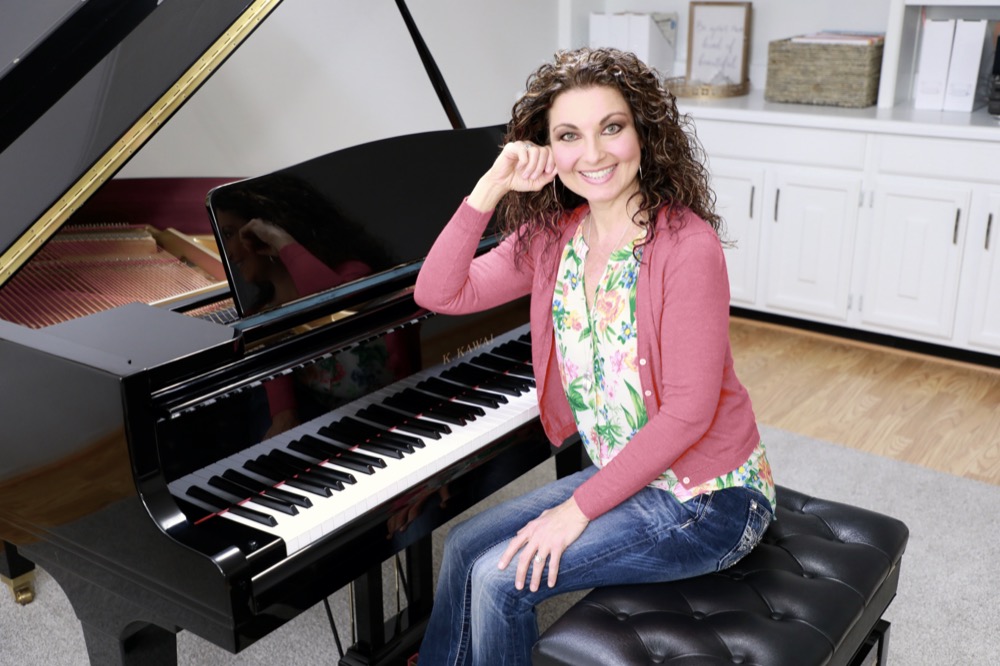7 Unique Ways to Rock Your First Month of Piano Lessons with Activities Students Love
This post may contain affiliate links. If you purchase something through an affiliate link, I will receive a small commission at no cost to you. For more information, read the disclosure statement here.

Looking for ways to rock your first month of piano lessons? We have you covered!
Whether you are a seasoned teacher or brand-new to the profession of piano teaching, your lessons can be fresh and exciting with the addition of a few creative, educational music resources that your young students will love!
This beginning piano mega bundle of 14 beginning piano games, activities and worksheets for piano lessons will not only transform your teaching, but the activities will also delight your students and help with student retention.
Why? Because when students are having fun (shhhh…. don’t tell them they are actually learning), they will want to continue with their piano lessons. You’ll become known as the go-to teacher for beginner piano students. It will be a win/win situation for all involved. 😀
In this blog post, we’ll dive into the first seven fantastic beginning piano activities and worksheets. You, the creative piano teacher, can save time and money with this incredible bundle, impressing both students and parents alike!
As you’ll read below, all of the activities are very easy to print and use immediately. Save time planning for lessons by using these ready-made, professional-looking materials designed by highly qualified, experienced piano teacher and piano teaching resource designer Melody Payne.
If you aren’t sure what concepts to teach and review for the first few weeks of piano lessons, these seven concepts will guide you to rock your first month of piano lessons.
1. Piano Finger Numbers Activities
Do you teach very young children, either individually or in a group? Need a fun idea for that first month of piano lessons? The Beginning Piano Mega Bundle is perfect for them. You’ll receive:
- worksheets designed to engage your young students in identifying finger numbers
- four short stories centered around Froggy the Chef that teachers can read to their students to add interest
- a coloring page featuring Froggy and finger numbers, of course
- answer keys

This is ideal for students who are in their first few weeks of piano lessons, or littles who have been in lessons for awhile but are still struggling with really knowing their finger numbers.
Teachers can print out the colorful set of worksheets with the cute froggy clip art, or the black and white set with no clip art, no story pages, and no coloring pages. This set would be suitable for any age student, particularly those who are beyond the primary school years.
I’m impressed by the various ways in which students review their left and right hand finger numbers in this resource. And teachers will find that the stories about Froggy the Chef bring continuity and a theme throughout the students’ learning journey — perfect!
2. Piano Key Spelling Bee Game for your first month of piano lessons!
Usually, the names of the white piano keys are taught within the first month of lessons. The Piano Key Spelling Bee provides an excellent, entertaining way to review them. The set includes:
- game boards
- score cards for students to write down their answers (laminate so you can re-use them)
- 32 piano key spelling bee word cards (16 three-letter words, and 16 four-letter words)
- images to print on the backs of the cards if desired
- blank cards that you can customize with your own spelling words
- a black & white version to save you ink!
- a version without the bee clipart — perfect for older beginners

There are full instructions for use, of course, but the basic concept you use is this: Each bee-themed card has a short keyboard image on it with either three or four white notes shaded in a different color. Students have to identify the names of these white keys; they all spell a simple word, e.g. “FADE”, BEEF”, etc.
The genius thing is that the keyboard images don’t all begin with “C”. Some begin with “C”, while others begin with “F”. Students really need to be able to identify the white notes in relation to the black key groupings rather than just by counting up from “C”.
Using the game board is optional, but I know that students will enjoy rolling a die and advancing their token towards the cute clip art bee hive and bee that await them.
This download also comes with a bonus version — a rainbow-themed game for those who prefer it. Or, after a few months have gone by since playing the spelling bee game, the teacher could be “sneaky” and tell the students that they are going to play a “new” game. It will look different from the original game, but the teacher will know the truth! 🙂
For even more teaching tips & game ideas using the Piano Key Spelling Bee Game, read The Perfect Keyboard Geography Game for Beginner Piano Lessons.
3. Rock Your First Month of Piano Lessons Using Rhythm Animals for Rhythm Exploration and Performance!
It goes without saying that teaching students rhythm right from the start is essential. Why not use these cute, animal-themed rhythm cards for your PreK – Grade One children and help the first month of piano lessons go extra smoothly?
Each of these animal cards has a cute image of a mouse, raccoon, etc. plus basic rhythms such as a quarter rest, quarter note, half note, or dotted half note. On some, the stems are facing up; on others, they are pointing down.
On some cards, there is just one note/rest per card. Students can use these animal cards to practice clapping and saying the name of each note or rest.

Numerous suggestions are given in the teacher information pages on how to use the cards. For example, students could put two or more cards together and clap the rhythm. Or, they could get up and move like the animal on the card, or make a sound like the animal.
There are also mixed rhythm cards with multiple notes/rests per card and words such as “Mouse Rest” or “Bear Rest” with the appropriate rhythm displayed under the words.
There’s a bonus cut and paste composition activity that students will love as well.
This resource is packed full of possibilities limited only by your imagination. You surely will rock your first month of piano lessons with these fun, engaging cards!
If you want to read even more about these rhythm cards, check out our blog post, Preschool Rhythm Activity Cards For Engaging Piano Lessons.
4. Piano Key Matching Monsters are Terrific for the First Month of Piano Lessons!
Choose from adorable green, yellow, or black & white clipart monsters. No matter what you choose, students are sure to love learning their piano keys this way.
Designed with young children in mind, each card has either a short keyboard image or just three or four white piano keys. A dot appears on one of the notes. On a corresponding card, a large font size note name is displayed, along with the friendly monster, of course!

Here are a few ideas for use:
- Play a matching game. Shuffle the cards, lay them all face down on a table, and have your student draw two cards. If the cards are a match, they keep the cards and turn over two more. If not, they turn the cards face down again and now it’s the next student’s (or teacher’s) turn.
- Hand all the cards out to a group of students. When the teacher says “go,” they race to find their partner.
- Using the above procedure, this is how I got students into random partners to prepare them for the next activity that I had planned, one that required students to pair up.
There are so many ways to use these cards in your first month of piano lessons. Let us know in the comments below what other ways you’ve used these piano key matching cards.
5. Another Fabulous Game for the First Month of Piano Lessons: “Beethoven Says…” Finger Number Game
This is an wonderful resource packed with the following:
- full instructions detailing how to play
- 70 color cards with many combinations of finger numbers for both right and left hand
- some cards without the words “Beethoven says…” on them
- a black & white version of everything

This card game would be great fun to play in a group — summer music camp anyone? It could also be played just as successfully with only one student during a private piano lesson.
“Beethoven says…” is played similarly to “Simon says…” except students have to go to the piano and play certain notes with certain fingers according to what their card indicates.
I think it’s fantastic that in this game, students are playing different notes with various fingers and not just playing the keys in one certain hand position. The sweet cartoon drawings of Beethoven on each card could inspire a brief discussion of the composer as well. Bonus!
6. “Feed the Music Monster” Pre Staff White Keys Game for the First Month of Piano Lessons
Add an extra layer of fun to your first month of piano lessons with this imaginative, exciting game. It’s perfect for students who haven’t learned to read notes on a staff yet. Here’s what you get:
- a complete set of supplies and instructions, as well as ideas for use
- the sweet, full page monster image to print on cardstock, cut out, and attach to a small paper bag with a hole for the mouth
- 24 cards with various quarter, half, and whole note rhythms on them. They are all in 4/4 time and consist of just two measures per card. A few quarter rests are included as well. Each note is labelled with the note name inside the note head. The direction of the notes is clear (are they going up, down, or are they the same?).
- a starting finger number to guide the student

Naturally, the cute monster adorns each card to give the student a friendly wave “hello.”
You can read about more reasons to use this and other versions of “Feed the Music Monster” sight-reading games here. Now that there’s a version of the game for pre-staff piano students, I plan to use it right away!
Use the game for ear training or sight reading. Either way, your young students will absolutely love it!
Pro tip: Print the game cards and music monster onto bright white card stock. Laminate the cards and the music monster for a sturdy game that’s perfect for little fingers!
7. Using “Piano Keys Are a Breeze” Worksheets for the First Month of Piano Lessons
Looking for a way to help your beginner students effectively learn keyboard geography? Here are 11 colorful, sequential pages designed to help your beginner piano students learn the white keys on the piano. A black & white version, as well as answer keys, are also available.
These worksheets have students practice naming the keys in various ways. The children will never be bored, nor will it seem repetitious to them.
I used this set of worksheets/activities last summer during my piano camps; the students completed a few pages each day. Those students who continued with group lessons in the fall were consistently able to identify their white keys faster than students who had not done the summer camp.
Hmmm… could it be that “Piano Keys Are a Breeze” contributed to their success? I believe so! Read more details and get more teaching ideas for using Piano Keys are a Breeze here plus browse all our Piano Keys are a Breeze worksheets here.

And there you have it — the first seven of fourteen incredible resources in this beginning piano games and activities bundle. All of these resources are highly engaging, use a child-centered approach, and have age-appropriate designs.
They can be used for private, group, classroom, or summer camp experiences. And of course, they can all be used for online lessons. Teachers who wish to save on paper and ink can always use the products digitally instead of printing them out.
If you seek an interactive approach for your newest, youngest students and want to give them a solid foundation in the first month of piano lessons, use this amazing and affordable bundle of music games, activities, and worksheets.
Coming next month… another blog post detailing resources #8 – 14 of this bundle. The value you get in this bundle cannot be overstated!
Get your students excited about learning these basic musical concepts, introducing them to finger numbers, keyboard geography, and rhythm starting today. Grab your beginning piano mega bundle now and watch the learning begin!
What beginning piano concepts do you use in the first month of piano lessons?
I’d love to hear what you use in your studio to rock your first month of piano lessons! Hit “comment” and share away!
More blog posts to help you with teaching piano…
Don't miss out!
Follow on Facebook and Instagram, join the best Facebook group for piano teachers, and subscribe to the newsletter to get helpful teaching tips, resources, and tutorials delivered straight to your inbox every week.
Celeste-tina Hernandez
Celeste-tina Hernandez
Welcome!

Hi! I’m Melody Payne, a pianist and piano teacher, educational resource author, a fun-loving wife to the most wonderful and talented hubby I could ask for, and a lifelong learner who loves to share. I want to make your life as a music teacher easier by writing and sharing helpful and relevant music teaching articles, and by creating educational resources with your very own students in mind. If you are a parent who wants to enroll your child in piano lessons, I’d love for us to get started building those skills that can give your child a lifetime of musical enjoyment!

